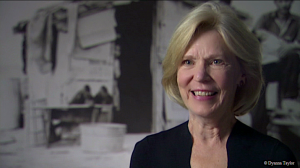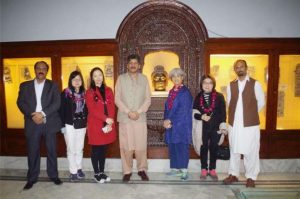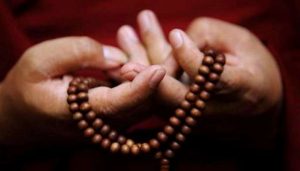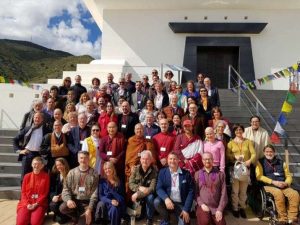Shambhala Publications released From Foundation to Summit: A Guide to Ngöndro and the Dzogchen Path by Orgyen Chowang in July 2024. A 400-page enchiridion on the ascension of spiritual awakening, the author considers it a commentary to the book A Cascading Waterfall of Nectar by Thinley Norbu Rinpoche, and as such it provides a framework for this book.
Thinley Norbu Rinpoche was a great teacher of Dzogchen who passed away in 2011. His teachings covering the entire path from ngöndro (preliminary practices) through to Dzogchen. At the behest of the author, Orgyen Chowang, although despite some initial hesitation, Thinley Norbu Rinpoche included Dzogchen teachings in his text about guru yoga, particularly for those who wish to advance directly.
It is with gratitude to a dedicated team that this book was able to take shape. Chuck Goldman is one of Orgyen Rinpoche’s longtime students and the editor of From Foundation to Summit. He edited and consolidated the considerable volume of teachings, while Ngawang Zangpo translated Orgyen Rinpoche’s teachings as he taught these transformative practices to his students.
This was influenced in turn by Patrul Rinpoche, a beloved teacher from the Nyingma school of Tibetan Buddhism, known for his simple lifestyle and insight teachings. Patrul Rinpoche himself authored several books, including the Words of My Perfect Teacher.* Patrul Rinpoche believed that sacred teachings should be helpful and easy to understand, and Thinley Norbu Rinpoche implemented this idea when writing A Cascading Waterfall of Nectar. He has assumed a straightforward, relatable writing style that avoided complex outlines and fancy poetry. This approach, praised by Dzogchen master Jigme Phuntsok Rinpoche (with whom the author spent nine years), is an example of the Nyingma lineage’s tradition of writing from intrinsic awareness.
The end result is that Orgyen Rinpoche’s teachings, blessed by Thinley Norbu Rinpoche himself, shares an ancient wisdom—which can be challenging for many people to grasp and is often wrapped up in flowery syntax—in a contemporary and grounded language.

As one might imagine, translating Tibetan thought processes into English poses challenges. The subject-object, actor-action-result structure of English can constrain the meaning of sentences in Tibetan. To address this, we are told by the editor, that he aimed to phrase Orgyen Rinpoche’s expressions in a “nondoing” way. Thus Goldman invites more of an “active experience” for the readers, with adjunct footnotes and explanations (especially for Dzogchen teachings), as a helping hand along the way. I feel he succeeded. This book follows the order of ngöndro practice, but, as we are made aware, early chapters introduce advanced material, including Dzogchen terminology.
Dzogchen reminds us that the energy of life transcends everything that we hold on to as true or “real.” This energy lies beyond the human construct of something like nihilism and extends into a far greater reality that our limited minds cannot comprehend. It is essentially the practice of preparing for death. As I clumsily like to say, it is like preparing to catch the right bus for the next leg of the grand adventure—although there is no actual bus, no travel, and no destination, because they don’t really exist. Yet there is the adventure of the now, even if everything around this moment doesn’t exist either, and without any relative perspective this arguably renders the now asa mere construct.
However, a book like this becomes invaluable in the preparation of the mind. To recycle a story of my own experience as a young adult: I was helping to wallpaper someone’s house, learning on the job from someone who knew what they were doing. I was taught that 95 per cent of a good result was in the preparation of the walls: cleaning off the old paper; scraping the walls flat; filling in any scuffs; and degreasing the walls with a good soap wash and letting it dry completely; addressing any issues with the skirting boards and where the walls meet the ceiling; and fixing issues with doorframes and windowframes. Once, and only once all these preparations were properly satisfied could we actually begin with the new wallpaper. And it is much the same when it comes to working with our mind.
I have a proclivity toward neurology and quantum physics, and I see how mind training and dissolving kleshas as very much akin to rewiring the brain from the “negativity bias” (as neuropsychologist Rick Hanson expresses it), and prajna as akin to the quantum realm of protomatter. Without really understanding our subjective mind, let alone its formed biology, Dzogchen is utterly unfathomable and potentially even dangerous.
Training is like being taught exactly how to make a soufflé, rather than simply being handed eggs, flour, milk, and butter and then told to make it look like the picture in the cookbook. If, by some wonder, one gets it right on the first go, repetition may still prove to be a challenge. Furthermore, while it may not be as unfathomable or dangerous as nihilistic disassociation within a shimmering vibrating node of limitless energy renewing itself within a nano-moment in an expanse beyond the concept of measure—cooking a soufflé to perfection every time takes some skill. And so it may be with the essence of what it means to be sentient.
As such, the fact that we were born and are awake enough to read these words, let alone practise them, is a privilege not to be squandered, lest we not be so fortunate the next time; lest we show up at the bus stop and, in a panic, jump on the first one that comes along—destination unknown.
The concept of a precious human birth, however, does stress the rarity and significance of our existence at all.

Within this book, as part of our training, we are told of concepts such as the eight freedoms and 10 favorable conditions, and we are reminded that not all conditions are earthly. Taking the correct bus that allows us to practise the teachings leading to enlightenment includes factors such as not being born in a hell realm, as starving spirits, and as pragmatic as not being in places where positive teachings are rejected or lacking.
In the context of these practices, the fact that you were born into a situation in which you even have the thoughts that may bring you to a book like this means that you have struck the jackpot. Personally, I find that is reason enough to not waste a moment on trivialities that don’t matter, and to not take the time we have for granted—as we have no idea when this ride will come to an end.
Buried within the chapters of this book are meditations that we, especially in the West, would never have had access to not so long ago. We live in extraordinary times with a wealth of wonderful teachers, including our author, who can guide us through the secret techniques of tantric practices, even if at a relatively and necessarily rudimentary level when outside the sanctity of advanced retreats.
The author guides us from the Dudjom Tersar Ngöndro, which is a practice within the Dudjom lineage, with termas revealed by Dudjom Lingpa and Dudjom Rinpoche, through to taking refuge. From kayas to mandala offerings, yidam meditation and guru yoga to phowa and chöd. Even dakini practice with an unexpected Vajrayogini meditation would, while suitable for the general public, still not have been found in most books until recent years.
The feminine dakini practices are seen as a vehicle to union with the masculine energy. The understanding of ultimate reality as energy represented as a masculine drive of matter is never apart from antimatter energy represented by the feminine aspect, arguably tangoing within dark energy. It is most unfortunate that we attribute genders to these principles of proactive and reactive, expansive and redactive, peaking and troughing, setting the stage for the societal imbalances that we see today. However, if it is enlightenment that we seek, myopic attitudes require dissolving. Frustratingly, we still see the cultural patriarchal influences weave through the teachings and yidams of Buddhism.
In conclusion, this book is a wealth of glorious information that anyone on the path of wisdom would benefit from reading, although it may feel overwhelming for a neophyte. So just read it slowly, then read it all again—which I certainly will because this is a gem. And when you read it again, do the practices. As I like to say: the theory of breathing isn’t as useful as actually doing it.
* Orgyen Rinpoche tells us that Thinley Norbu Rinpoche encourages everyone to read Words of My Perfect Teacher as well as the detailed ngöndro commentary by his father, Dudjom Rinpoche, especially for the serious student of self-mastery. It is a comprehensive guide on calming the mind, insight meditation, the relationship between meditative and post-meditative states, and the stages of enlightenment, that makes it easier to navigate the meditation path and overcome obstacles, The guide covers various perspectives, including Mahayana, Mahayoga, Anuyoga, Atiyoga, trekchöd, and thögal.
See more
From Foundation to Summit: A Guide to Ngöndro and the Dzogchen Path (Shambala Publications)
Related features from BDG
Book Review: This Fresh Existence – Heart Teachings from Bhikkhuni Dhammananda
Book Review: Gardens of Awakening by Kazuaki Tanahashi
Book Review: Tibetan Buddhism: A Guide to Contemplation, Meditation, and Transforming Your Mind by Khenpo Sodargye














